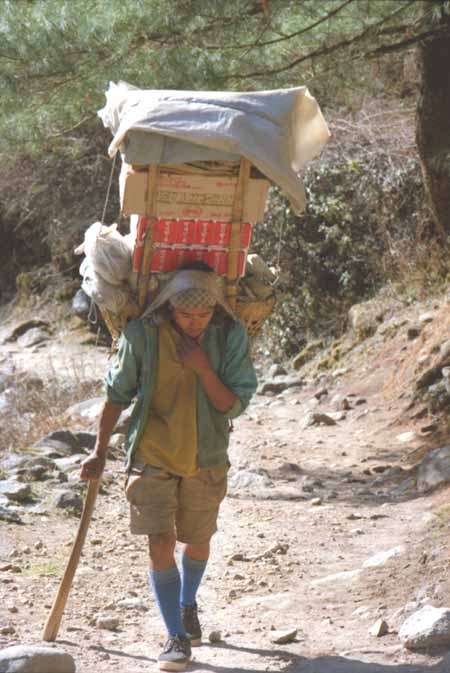Heavy Weights in Thin Air

Porters in Nepal frequently carry heavy loads - sometimes weighing as much as they do - up in the thin air of the Himalayas.? Scientists have quantified the porters' energy efficiency and found it exceeds that of trained soldiers with backpacks.
The Nepalese porters place supplies and goods in a basket, called a "doko."? But unlike Western backpacks worn on the shoulders or chest, the doko is held by a single strap - or "namlo" - which goes on the person's head.
Scientists from the Universit? Catholique de Louvain in Belgium studied porters carrying cargo up to a weekly bazaar in the town of Namche - altitude 11,500 feet (3500 meters) - not far from Mt. Everest.?
Starting in the Kathmandu valley, the 60-mile (100-kilometer) trek - with its many steep ascents and descents - takes the porters 7 to 9 days to complete.?
On a single day, the researchers counted 545 male porters and 97 female porters on route to the bazaar.? Their ethnicities were predominantly Rai, Sherpa, and Tamang.
Randomly chosen porters were weighed along with their dokos.? The average male was carrying 93 percent of his body weight, whereas the average female carried 66 percent.?
A fifth of the males had dokos that weighed a quarter more than they did (125 percent), and one unlucky fellow was stuck with a basket nearly twice his weight (183 percent).? The scientists estimate that 30 tons of materials were transported to Namche on the day they were observing.
Sign up for the Live Science daily newsletter now
Get the world’s most fascinating discoveries delivered straight to your inbox.
Eight of the porters were asked to don masks that measured how much oxygen they consumed and how much carbon dioxide they produced.? From this, the amount of energy burned in certain activities was calculated.
It was found that the Nepalese are more energy efficient than African women who carry water and wood on their heads.? Both of these head-toters have proven to be more efficient than soldiers who carry their supplies in backpacks.
But carrying style may not fully explain the incredible treks that are made. The researchers make no guess as to any Nepalese fitness secret, but they do note that the porters walk slowly and take several breaks.
The research was reported in the June 17 issue of the journal Science.










